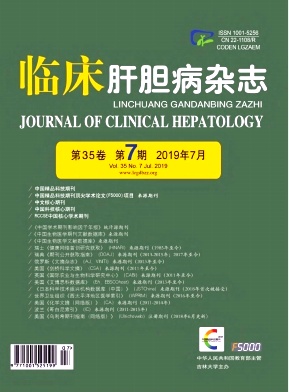|
[1]BRAY F, FERLAY J, JEMAL A, et al.Global cancer statistics2018:GLOBOCAN estimates of incidence and mortality worldwide for 36 cancers in 185 countries[J].CA Cancer J Clin, 2018, 68 (6) :394-424.
|
|
[2]CHEN W, ZHENG R, BAADE PD, et al.Cancer statistics in China, 2015[J].CA Cancer J Clin, 2016, 66 (2) :115-32.
|
|
[3]ZHANG C, WANG J.Experience in treating hepatocellular carcinoma by classical pescription[J].J Changchun Univ Chin Med, 2018, 34 (5) :908-910. (in Chinese) 张驰, 王军.原发性肝细胞癌经方论治管见[J].长春中医药大学学报, 2018, 34 (5) :908-910.
|
|
[4]XU M, ZHENG XM, QIU WQ, et al.MicroRNA-190b regulates lipid metabolism and insulin sensitivity by targeting IGF-1 and ADAMTS9 in non-alcoholic fatty liver disease[J].J Cel Biochem, 2018, 119 (7) :5864-5874.
|
|
[5] TORNQVIST H, BELFRAGE P.Purification and some properties of a monoacylglycerol hydrolyzing enzyme of rat adipose tissue[J].Biol Chem, 1976, 251 (3) :813-819.
|
|
[6]GUZMAN M.A new age for MAGL[J].Chem Biol, 2010, 17 (1) :4-6.
|
|
[7]NOMURA DK, LONG JZ, CRAVATT BF, et al.Monoacylglycerol lipase regulates a fatty acid network that promotes cancer pathogenesis[J].Cell, 2010, 140 (1) :49-61.
|
|
[8] CIPRIANO M, GOUVEIA-FIGUEIRA S, FOWLER CJ, et al.The influence of monoacylglycerol lipase inhibition upon the expression of epidermal growth factor receptor in human PC-3 prostate cancer cells[J].BMC Res Notes, 2014, (7) :441.
|
|
[9]QIN H, RUAN ZH.The role of monoacylglycerol lipase (MAGL) in the cancer progress[J].Cell Biochem Biophys, 2014, 70 (1) :33-36.
|
|
[10]CHEN XF, ZHANG JY, XU ZP, et al.LPSS-NH2-medicated transfection of) monoacylglycerol) lipase) shRNA) down-regulates prostaglandin) E2) and) inhibits proliferation and) invasion in hepatocellular cell lines[J].J Third Milit Med Univ, 2018, 40 (19) :1762-1769. (in Chinese) 陈先锋, 张俊勇, 龚建平, 等.硅酸盐介孔材料介导的MAGL-shRNA转染下调前列腺素E2抑制肝细胞癌细胞株增殖与侵袭[J].第三军医大学学报, 2018, 40 (19) :1762-1769.
|
|
[11]NIU D, ZHANG J, GONG J.et al.Monodispersed and ordered large-pore mesoporous silica nanospheres with tunable pore structure for magnetic functionalization and gene delivery[J].Adv Mater, 2014, 26 (29) :4947-4953.
|
|
[12] JAUREGUIBERRY MS, TRICERRI M, RIMOLDI OJ, et al.Role of plasma membrane lipid composition on cellular homeostasis:Learning from cell line models expressing fatty acid desaturases[J].Acta Biochim Biophys Sin (Shanghai) , 2014, 46 (4) :273-282.
|
|
[13] ZHANG J, GONG JP, QIAO ZR, et al.The combined antitumor effects of 125I radioactive particle implantation and cytokine-induced killer cell therapy on xenograft hepatocellular carcinoma in a mouse model[J].Technol Cancer Res Treat, 2017, 16 (6) :1083-1091.
|
|
[14] ZHANG J, LIU ZJ, GONG JP, et al.Monoacylglycerol lipase:A novel potential therapeutic target and prognostic indicator for hepatocellular carcinoma[J].Sci Rep, 2016, 6:35784.
|
|
[15] SUN H, JIANG L, HUANG Y, et al.Potential tumor-suppressive role of monoglyceride lipase in human colorectal cancer[J].Oncogene, 2013, 32 (2) :234-241.
|
|
[16]PAGANO E, BORRELLI F, ORLANDO P, et al.Pharmacological inhibition of MAGL attenuates experimental colon carcinogenesis[J].Pharmacol Res, 2017, (119) :227-236.
|
|
[17]TANG ED, WANG CY.YAP-mediated induction of monoacylglycerol lipase restrains oncogenic transformation[J].Cell Signal, 2015, 27 (4) :836-840.
|
|
[18] LLOYD PG.Caveolin-1, antiapoptosis signaling, and anchorage-independent cell growth.Focus on"Caveolin-1regulates Mcl-1 stability and anoikis in lung carcinoma cells"[J].Am J Physiol Cell Physiol, 2012, 302 (9) :c1282-c1283.
|
|
[19] ZHU W, ZHAO Y, WANG L, et al.Monoacylglycerol lipase promotes progression of hepatocellular carcinoma via NF-κB-mediated epithelial-mesenchymal transition[J].J Hematol Oncol, 2016, 9 (1) :127.
|
|
[20] REN J, XIAO YJ, XU Y, et al.Lysophosphatidic acid is constitutively produced by human peritoneal mesothelial cells and enhances adhesion, migration, and invasion of ovarian cancer cells[J].Cancer Res, 2006, 66 (6) :3006-3014.
|
|
[21]MAZZOCCA A, ANTONACI S, GIANNELLI G.Tumor-secreted lysophostatidic acid accelerates hepatocellular carcinoma progression by promoting differentiation of peritumoral fibroblasts in myofibroblasts[J].Hepatology, 2011, 54 (3) :920-930.
|
|
[22]ZHANG H, BAI X, LENG J, et al.Prostaglandin E2 promotes hepatocellular carcinoma cell invasion through upregulation of YB-1 protein expression[J].Int J Oncol, 2014, 44 (3) :769-780.
|
|
[23]NOMURA D, CAROLYN H, ANNA W, et al.Monoacylglycerol lipase regulates 2-arachidonoylglycerol action and arachidonic acid levels[J].Bioorg Med Chem Lett, 2008, 18 (22) :5875-5878.
|
|
[24] MACCARRONE M, DI RIENZO M, FINAZZI-AGRA, et al.Binding, degradation and apoptotic activity of stearoylethanolamide in rat C6 glioma cells[J].Biochem J, 2002, 366 (Pt1) :137-144.
|
|
[25] HU WR, LIAN YF, ZENG YX, et al.Monoacylglycerol lipase promotes metastases in nasopharyngeal carcinoma[J].Int JClin Exp Pathol, 2014, 7 (7) :3704-3713.
|
|
[26]CHAI C, RIVKIN M, GALUN E, et al.Metabolic circuit involving free fatty acids, microrna 122, and triglyceride synthesis in liver and muscle tissues[J].Gastroenterology, 2017, 153 (5) :1404-1415.
|
|
[27] PACELLA I, BARNABA V, PICONESE S, et al.Fatty acid metabolism complements glycolysis in the selective regulatory Tcell expansion during tumor growth[J].Proc Natl Acad Sci US A, 2018, 115 (28) :e6546-e6555.
|
|
[28] JAUREGUIBERRY MS, TRICERRI M, RIMOLDI OJ, et al.Role of plasma membrane lipid composition on cellular homeostasis:learning from cell line models expressing fatty acid desaturases[J].Acta Biochim Biophys Sin (Shanghai) , 2014, 46 (4) :273-282.
|
|
[29] MAZZOCCA A, ANTONACI S, GIANNELLI G.Tumor-secreted lysophostatidic acid accelerates hepatocellular carcinoma progression by promoting differentiation of peritumoral fibroblasts in myofibroblasts[J].Hepatology, 2011, 54 (3) :920-930.
|
|
[30] ZHANG H, BAI X, LENG J, et al.Prostaglandin E2 promotes hepatocellular carcinoma cell invasion through upregulation of YB-1 protein expression[J].Int J Oncol, 2014, 44 (3) :769-780.
|









 本站查看
本站查看




 DownLoad:
DownLoad: